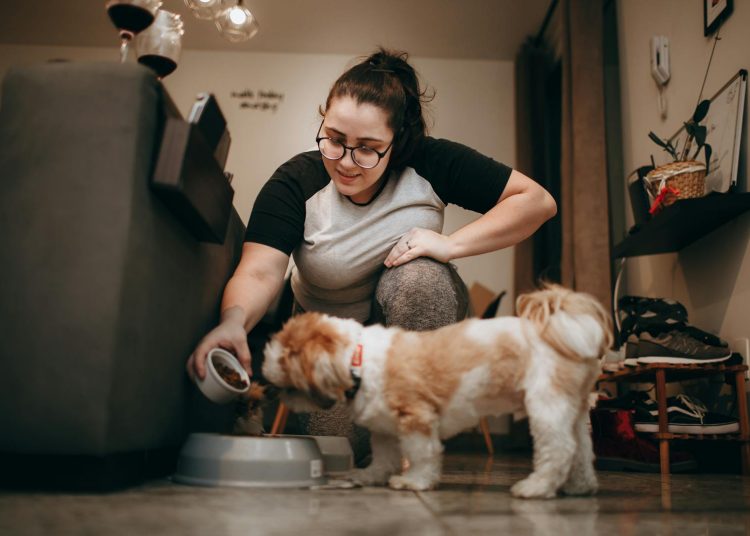Active pets, whether they are high-energy dogs, playful cats, or other animals that lead active lifestyles, require specialized nutrition to support their energy needs, muscle development, and overall health. Just like athletes need specific diets to perform at their best, pets with high activity levels also need balanced, nutrient-rich diets that provide the fuel they need. Understanding what to feed your active pet is essential to keeping them happy, healthy, and ready for adventure. In this article, we explore the best nutritional practices for active pets, focusing on the key nutrients they need to thrive.
The Importance of a Nutrient-Rich Diet for Active Pets
Active pets expend more energy than their more sedentary counterparts, which means they need higher-calorie diets that provide the necessary nutrients to fuel their activities. However, it’s not just about providing more calories—it’s also about ensuring those calories come from high-quality ingredients that support overall health. The right diet will help your pet maintain strong muscles, healthy joints, and a well-functioning cardiovascular system, all of which are essential for an active lifestyle.
Key Nutrients for Active Pets
1. Protein: The Building Block for Muscles
Protein is the most important nutrient for active pets, as it provides the building blocks—amino acids—necessary for muscle growth, repair, and maintenance. High-quality animal proteins, such as chicken, beef, fish, and lamb, are rich in essential amino acids that help keep muscles strong and healthy.
Active pets have higher protein requirements than less active animals, as they need protein to repair muscles that are used during exercise and physical activity. When choosing food for your active pet, look for products that list a named animal protein as the first ingredient, and ensure that the protein content meets their specific needs.
2. Healthy Fats: Concentrated Energy Source
Fats are an essential energy source for active pets, providing more than twice the energy of carbohydrates or protein. They also help with the absorption of fat-soluble vitamins and contribute to healthy skin and coat. Omega-3 and omega-6 fatty acids, in particular, are crucial for active pets, as they help reduce inflammation, support joint health, and promote a shiny coat.
Common sources of healthy fats include fish oil, flaxseed oil, and animal fats such as chicken fat. Omega-3 fatty acids are especially beneficial for active pets with joint stress, as they help reduce inflammation and support mobility.
3. Carbohydrates: Quick Energy for Active Pets
Carbohydrates are another important source of energy for active pets. While protein and fat provide sustained energy, carbohydrates offer quick-release energy that helps pets perform during periods of intense activity. Whole grains, sweet potatoes, and brown rice are excellent sources of complex carbohydrates that provide a steady release of energy throughout the day.
It’s important to choose carbohydrate sources that are easy to digest and rich in nutrients. Avoid low-quality fillers like corn and soy, which can be harder for pets to digest and provide limited nutritional value.
4. Vitamins and Minerals: Supporting Overall Health
Active pets require a wide range of vitamins and minerals to maintain their health and support various bodily functions. Vitamin E and Vitamin C are antioxidants that help protect cells from oxidative stress, which can be caused by intense physical activity. B vitamins are important for energy metabolism, while calcium and phosphorus are crucial for maintaining strong bones and muscle function.
Electrolytes, such as sodium, potassium, and magnesium, are also important for active pets, especially those that participate in prolonged physical activity. These minerals help maintain hydration and regulate nerve and muscle function, reducing the risk of muscle cramps and fatigue.
Choosing the Right Food for Your Active Pet
1. High-Quality Commercial Pet Food
Many commercial pet food brands offer formulas specifically designed for active pets. These foods are often labeled as “performance” or “high-energy” formulas and contain higher levels of protein, fat, and calories to meet the needs of active animals. When selecting a commercial pet food, look for products that carry an AAFCO nutritional adequacy statement, which ensures that the food meets established nutrient profiles for active pets.
It’s important to select a food that uses high-quality ingredients, including named animal proteins, healthy fats, and whole grains. Avoid products that contain excessive fillers, artificial additives, or by-products, as these can be harder for your pet to digest and provide limited nutritional value.
2. Wet vs. Dry Food
Wet food can be a good option for active pets, as it has a higher moisture content, which helps keep them hydrated. This is especially important for dogs or cats that may not drink enough water during or after exercise. Wet food is also highly palatable, making it a good choice for pets that are picky eaters.
Dry food is convenient and can help maintain dental health by reducing plaque buildup. Many pet owners choose to feed a combination of both wet and dry food to provide a balanced diet and the benefits of both types.
Homemade Diets for Active Pets
Some pet owners prefer to prepare homemade meals for their active pets to ensure they receive high-quality ingredients and balanced nutrition. If you decide to prepare homemade meals, it’s important to work closely with a veterinarian or pet nutritionist to create a complete and balanced diet. Active pets have specific nutritional needs, and an imbalanced diet can lead to deficiencies or excesses that can impact their health and performance.
A typical homemade meal for an active pet might include:
- Lean protein: Chicken, beef, or fish
- Carbohydrates: Brown rice, quinoa, or sweet potatoes
- Vegetables: Carrots, peas, or spinach
- Healthy fats: Fish oil or flaxseed oil
Ensure that the homemade diet includes all essential vitamins and minerals, either through a high-quality supplement or by carefully balancing ingredients to meet your pet’s needs.
Feeding Tips for Active Pets
1. Portion Control and Meal Timing
Active pets require more calories than sedentary pets, but it’s important to avoid overfeeding, which can lead to weight gain. Work with your veterinarian to determine the appropriate portion size for your pet based on their activity level, breed, and metabolism. Portion control is key to maintaining a healthy weight and ensuring that your pet has enough energy without gaining excess fat.
For pets that participate in intense physical activities, consider feeding smaller meals throughout the day to provide a steady source of energy. Feeding a meal 2-3 hours before exercise can help ensure your pet has the fuel they need for peak performance, while a post-exercise meal can help with recovery.
2. Hydration is Key
Hydration is crucial for active pets, especially those that engage in strenuous activities or exercise in hot weather. Make sure your pet has access to fresh water at all times, and encourage them to drink before, during, and after exercise. For dogs that need extra encouragement to drink, try adding a small amount of low-sodium chicken broth to their water or offering ice cubes as a treat.
3. Monitor Body Condition and Adjust as Needed
It’s important to monitor your pet’s body condition regularly to ensure they are receiving the right amount of nutrition. If your pet is losing weight, seems lethargic, or is not recovering well after exercise, they may need more calories or specific nutrients. Conversely, if your pet is gaining weight or becoming less active, it may be necessary to reduce portion sizes or adjust their diet.
4. Use Supplements if Needed
Depending on your pet’s activity level and specific needs, they may benefit from additional supplements. Common supplements for active pets include:
- Omega-3 fatty acids: To reduce inflammation and support joint health.
- Glucosamine and chondroitin: To support joint function and prevent injuries.
- Probiotics: To promote a healthy gut and improve nutrient absorption.
- Antioxidants: To combat oxidative stress caused by intense physical activity.
Always consult your veterinarian before adding supplements to your pet’s diet to ensure they are appropriate and safe.
Special Considerations for Different Types of Active Pets
1. Active Dogs
Working dogs, such as herding dogs, hunting dogs, and agility competitors, have higher energy needs than most companion dogs. These dogs require a diet that is high in protein and fat to support their energy expenditure. Performance dog foods are often the best choice for working dogs, as they are specifically formulated to meet their unique nutritional needs.
2. Active Cats
Cats that are active hunters or spend a lot of time outdoors need a diet that supports their high energy levels. Cats are obligate carnivores, which means they require a diet rich in animal protein. Active cats may benefit from wet food, as it provides additional moisture and is often more palatable than dry kibble. Look for cat food formulas that are high in protein and include omega-3 fatty acids to support joint health and mobility.
Final Thoughts on Feeding Active Pets
Feeding an active pet requires a thoughtful approach to ensure they receive the right balance of nutrients to support their energy levels, muscle development, and overall health. By choosing high-quality food, monitoring portion sizes, ensuring proper hydration, and adding supplements if needed, you can help your active pet live their best and healthiest life. Always consult your veterinarian for personalized recommendations based on your pet’s unique needs and activity level.








